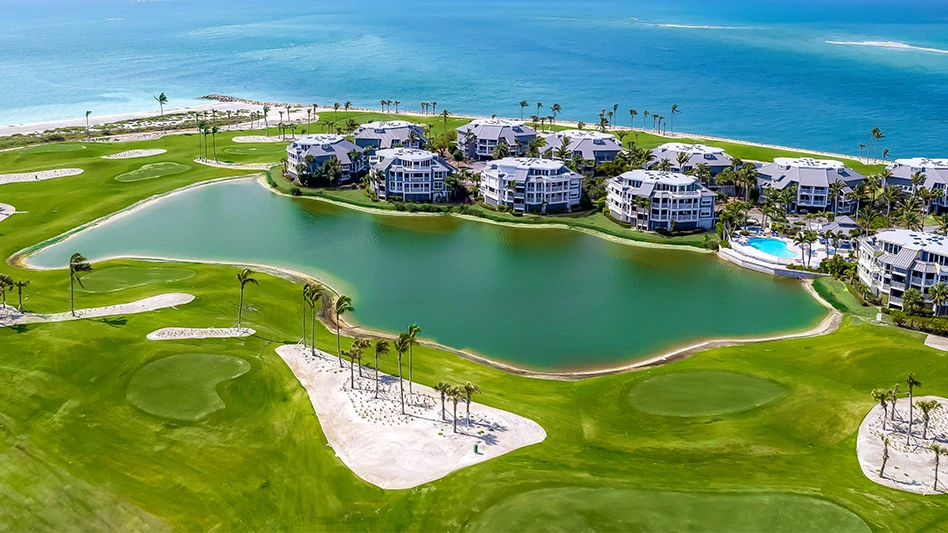
Courtesy of South Seas Resort (2)
South Seas, on Captiva Island along Florida’s Gulf Coast, opened its new 12-hole golf course, The Clutch. Mixing water and island views with fun-inspired golf, The Clutch is a family-friendly short course designed by Beau Welling and constructed as part of the rebuilding efforts following Hurricane Ian.
The Clutch is named after a turtle’s nest and is a walking-focused course that takes 60 to 90 minutes to play. Holes are designed with individual, distinctive challenges and feature multiple routes of play to cater to golfers of every skill level.
“The course is positioned to be a contender for top short courses in the U.S., competing with the likes of Pinehurst and Pebble Beach,” South Seas general manager Shawn Farrell said. “The appeal of this course at a resort like South Seas is the time available to enjoy all of the resort amenities and still take in a quick round of challenging golf.”
The new logo for The Clutch, a turtle holding a golf flag, and overall branding are carried throughout the course with signage, holes and merchandise. For the player who makes a hole in one, a challenge coin designed specifically for that hole will commemorate the occasion.


The 12 holes of The Clutch, which is exclusively available for resort guests and Captiva Club members, are named after area history, landscape and wildlife that can be seen throughout the destination.
No. 1: The Calusa
An homage to the Native American inhabitants of Captiva Island, the Calusa or “Shell Indians” are considered the first shell collectors.
No. 2: Key Lime
The second hole honors South Seas’ early years as a key lime farm owned by the Chadwick Family. They created a salt-resistant lime named the Chad Lime and became the world’s biggest supplier of the fruit.
No. 3: Mariner
Named in honor of the beloved hotel ownership group, Mariner Group, which undertook the most substantial development of South Seas, making it an expansive resort and cherished destination in the early 1970s.
No. 4: Heron
With multiple species of Heron calling South Seas home, they can be found near freshwater and coastal areas – making the island a birder paradise.
No. 5: The Vow
South Seas and Captiva is a long-favored location for wedding vows. With views of the wedding venue, players can be humorously reminded of the synergies between the game of golf and marriage.
No. 6: Osprey
On this hole, look up to see a large osprey platform adjacent to the green. Osprey prefer a “room with a view” and will return annually to the same platform for mating and during migration.
No. 7: Redfish
Named after the prized sport fish, the Redfish (or Red Drum) and the seventh hole run along the channel pass.
No. 8: Junonia
Named after the “unicorn” of shells – Junonia shells can be found on the island and are known for their beauty and apparent rarity – a coveted prize for collectors.
No. 9A: Hawksbill
An ode to this short hole and the smaller of the sea turtles inhabiting Captiva, their unique, beak-like mouth is perfect for finding food sources in cracks and crevices.
No. 9B: Loggerhead
Named for the Loggerhead turtle, this species of sea turtles is the most abundant in the United States and is recognizable by its large head.
No. 10: Egret
South Seas is home to several species of Egrets. They typically stand still, wade in shallow water, and watch for unsuspecting prey (or golf balls on the green!) to pass by.
No. 11: Snook
Snook are prized as game fish, renowned for their great fighting capability. They can be found along the beaches of Captiva.
No. 12: Manatee
Fondly referred to as “sea cows”, these gentle and slow-moving animals swim below the surface of the water and when active, come up to breathe every few minutes. Watch the manatees swim and play along the fairway and green – a grand finale to your round.
Captiva Island is connected to Florida’s mainland via Sanibel Causeway and a small bridge over Blind Pass, joining it to Sanibel Island. Tucked away at the northern end of the five-mile long, one-half-mile wide Captiva Island, South Seas is between Pine Island Sound and the Gulf of Mexico.
Latest from Golf Course Industry
- From the publisher’s pen: Conscientious of a bigger role
- Bernhard and Company partners with Laguna Golf Phuket
- Terre Blanche showcases environmental stewardship
- VIDEO: Introducing our December issue
- Bernhard and Company introduces Soil Scout
- Nu-Pipe donates to GCSAA Foundation’s Centennial Campaign
- GCSAA enhances golf course BMP tool
- Melrose leadership programs sending 18 to 2026 GCSAA Conference and Trade Show





